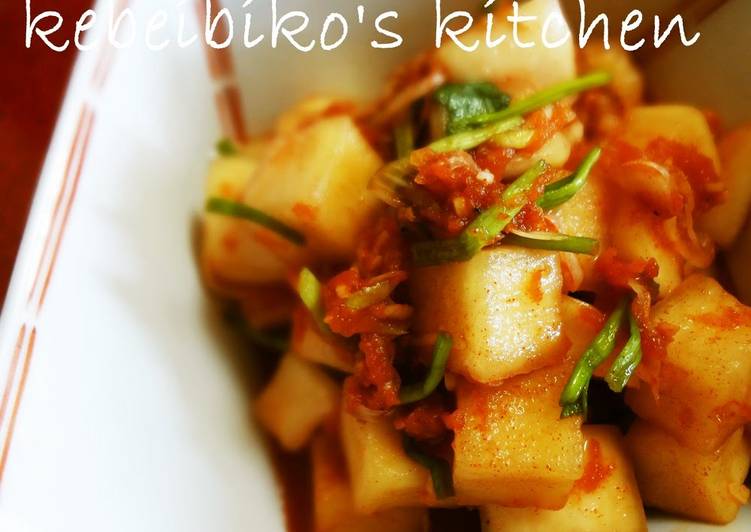Kkakdugi (Cubed Radish Kimchi). Kkakdugi (깍두기) is a kimchi made with Korean radish, mu (or moo, 무). It's an easy kimchi to make! Simply cut the radishes into cubes, salt for a short time, and then mix with the seasonings.
 It is also much simpler to make than the classic cabbage kimchi. Kkakdugi Korean Cubed Radish Kimchi Kkakdugi is a type of kimchi made from diced radish. It's a very common kind of kimchi and often used in Korean everyday meals along with baechu kimchi (napa cabbage kimchi). You can cook Kkakdugi (Cubed Radish Kimchi) using 12 ingredients and 13 steps. Here is how you cook that.
It is also much simpler to make than the classic cabbage kimchi. Kkakdugi Korean Cubed Radish Kimchi Kkakdugi is a type of kimchi made from diced radish. It's a very common kind of kimchi and often used in Korean everyday meals along with baechu kimchi (napa cabbage kimchi). You can cook Kkakdugi (Cubed Radish Kimchi) using 12 ingredients and 13 steps. Here is how you cook that.
Ingredients of Kkakdugi (Cubed Radish Kimchi)
- It's of Daikon radish.
- You need of Salt.
- You need of For the sauce:.
- You need of Apple.
- Prepare of Korean chili (finely powdered).
- It's of Fermented krill (saeujeot) (or fish sauce).
- Prepare of Finely chopped garlic.
- Prepare of Minced ginger.
- Prepare of Japanese leek (white part).
- It's of Sugar.
- It's of Salt.
- It's of Chinese celery (or garlic chives).
Radish kimchi is a kimchi made out of radish and its Korean name is Kkakdugi (깍두기). The name originates from kkakduk sseolgi (깍둑설기) in Korean. It describes the motion of cutting food in cubes. Many Koreans say Kkakdugi made in mid to late autumn (October to December) tastes best as it is the Korean traditional radish harvest season.
Kkakdugi (Cubed Radish Kimchi) instructions
- [Prep the daikon radish] Peel the daikon radish and cut into 2 cm cubes. Put in a plastic bag and mix evenly with 2 tablespoons of salt. Let sit for 1 to 2 hours. The daikon radish will release a lot of water....
- Occasionally rub the daikon from outside the bag. Thoroughly drain the daikon in a colander (let sit for about 30 minutes. In Step 4 photo, you can see that 350 ml of water drained from the daikon on the left-hand side)..
- [Prepping the sauce] Grate the apple. Cut the Japanese leek in half lengthways first and slice thinly and diagonally. Cut the Chinese celery into 3 cm widths. Put all the sauce ingredients into a bowl and combine..
- After the red colour from the chill is evenly distributed, add the daikon. Stir well (if your skin is sensitive, use gloves)..
- Pour the mixture into a storage container and chill in the fridge. You can eat it the following day. After 1 week to 10 days, the flavour will become well rounded. It will not be tart..
- This photo shows two day-old kkakduki..
- [Korean powdered chili] You can keep leftovers in the fridge to prevent discolouring..
- [Fermented krill] You can buy bottled ones at the supermarket and freeze leftovers..
- You can cook various dishes with it..
- "Stir-fried Potato with Fermented Krill" https://cookpad.com/us/recipes/145848-potato-fermented-krill-stir-fry.
- "Pale Pink Edamame Bean Rice with Fermented Krill" https://cookpad.com/us/recipes/145337-pink-tinged-fermented-krill-edamame-rice.
- "Pasta Aglio e Elio with Nanohana and Fermented Krill" https://cookpad.com/us/recipes/153061-spaghetti-aglio-e-olio-with-nanohana-and-fermented-krill.
- "Kimchi Hot Pot Sundubu Jjigae-style".
One of my favorites is an easy one, called Kkakdugi (깍두기). It's a large Korean radish that's been cubed up and seasoned very similarly to a standard napa cabbage kimchi. My mom made kkakdugi for us when we were kids, but only a couple of times per year. The cabbage version was the staple in our household, as it is in most Korean homes. Clean the radish with a kitchen brush and rise well.
Comments
Post a Comment